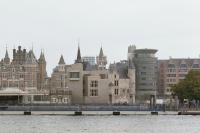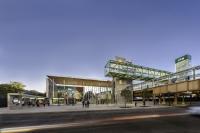ANZHI
Shanghai, China
dongqi Architects renovated the concept store of ANZHI to promote its brand identity. The store is located on the top floor of an industrial warehouse at M50 Creative Park of Shanghai. It is designed to showcase the Buddhist shrines and related souvenirs, and to enclose the interactive art installation – "Space" , by the artist Lin Wanshan. Therefore, the space functions both as a retail exhibition space and a place to settle the spirit.
The store’s architectural concept starts from the center of a circle, which is slightly deviates from the true geometric center of the building space. From the center, rings of concentric circles rise the one out of the other, propagating themselves like waves. After intricate calculation by dongqi Architects, the original two steel pillars of the industrial building are aligned at one ring of the circles. The arch between the pillar becomes a semi-transparent wall that divides the space into different sizes of spaces for shrine exhibition. Several parts of the old arch stairs are deliberately preserved by dongqi, as they bounce into the newly generated centric circles, presenting the collision of the new and the old.
The virtual Buddhist shrine is located at the center. Before reaching the interior center, customers need to take a walk through a circular labyrinth. Along their way, several Buddhist shrines are waiting for their close-up observation, during which, they could see through multiple layers of semi-transparent boards, and meet the eye-catching virtual shrine at the center. By the end of their journey, customers will stand in front of the virtual Buddhist shrine and begin their interaction with the artwork.
The original building is of typical industrial style. dongqi utilizes its unique floor height and builds a set of circular steel tracks, which rise along with the angled roof. Such structure creates a new arch space out of the original space. Moreover, all surface of the original space was painted black so that the outside boundary is blurred.
What’s more, customers will encounter with acrylic boards of different sizes. Hanging from steel tracks above, acrylic boards has surfaces composed of one-way mirrors. Acrylic boards inside will tilt further towards the center than those outside to show reflective effects at different angles. Moreover, steel tracks descending from the building roof has another role -- holding spotlights.
The light and shadow of the virtual digital Buddhist shrine reflect and refract the acrylic boards. As a result, the virtual Buddhist and illuminated shrines seem to appear at different locations from observations. When looking back, customers will see the reflection of themselves and the lit-up shrines behind them. As they move with changing lights, their perspectives shift between surroundings and reflected images as if the boundary of the virtual and the reality is blurred.
Project Name: ANZHI
Architect Firm: dongqi Architects
Project Team: JIANG Nan, Yujie Weng, Jinfan Xie
Location: Shanghai, China
Completion: 2018.11
Area: Around :202 ㎡
Photography: Raitt Liu
- Arquitectos
- dongqi Design
- Localização
- 3rd Floor, No.0 building, M50 Creative Park, Shanghai, China
- Ano
- 2018
- Equipa
- 姜南, 翁羽洁, 谢金杋



















